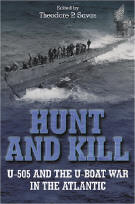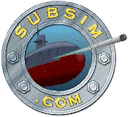|
|
||||
 Hunt
and Kill: U-505 and the U-boat War in the Atlantic Hunt
and Kill: U-505 and the U-boat War in the Atlantic
Author: Theodore P. Savas, ed. Foreword by Knight's Cross Holder When I was a schoolboy (about a million years ago), I liked to build plastic models. One model I remember building was of a German U-boat. The instruction sheet that came with my kit described how the U.S. Navy had captured U-505 during World War II. It went on to say that, after the war, the submarine was put on exhibit in a Chicago museum. At the time, my knowledge of geography left a lot to be desired, so I never wondered how a German submarine could find its way to the American Midwest. U-505 was the first enemy warship captured by the United States since the War of 1812. Much has been written about how Captain Daniel V. Gallery conceived of and successfully executed the plan that resulted in the capture of U-505. Hunt and Kill, from publisher Savas Beatie, is the first book to describe the complete history of U-505, from its commissioning as a warship in 1941 to its current status as an exhibit in Chicago’s Museum of Science and Industry. Hunt and Kill is a collection of essays by leading naval historians and U-boat scholars. Editor Savas has selected papers that, in telling the story of U-505, also give telling insight into Germany’s Kriegsmarine and the Allied naval and intelligence forces that opposed it. Chapters include: A Foreword, by former U-boat commander Erich Topp “No Target Too Far: The Genesis, Concept, and Operations of Type IX U-boats in World War II,” by Eric C. Rust. This chapter describes the rebirth of Germany’s U-boat arm following the first World War, the classes of boats that served in World War II, and the role of the Type IX boats as long-range commerce raiders. “A Community Bound by Fate: The Crew of U-505,” by Timothy Mulligan. This essay focuses on the officers and sailors that served on U-505, from its first war patrol in August, 1941 until its capture in June, 1944. In this brief span of time, U-505’s crew served under three Commanding Officers: charismatic and successful Kapitänleutnant Axel-Olaf Loewe; autocratic Oberleutnant Peter Zschech (who shot himself during a depth-charge attack); and Oberleutnant Harald Lange, a former merchant marine officer. “From Lion’s Roar to Blunted Axe: The Combat Patrols of U-505,” by Lawrence Paterson. This chapter covers U-505’s eleven war patrols prior to its capture by Gallery’s Task Force 22.3. In these patrols, U-505 sank eight ships totaling 44,962 tons.
“Deciphering the U-boat War: The Role of Intelligence in the Capture of U-505,” by Mark E. Wise and Jak P. Mallman Showell. In addition to the usual background information on Enigma, Ultra, and the code breakers of Bletchley Park and ONI, this chapter describes how the Allied benefited from their technical examination of U-505; testing of the submarine’s T-5 acoustic homing torpedoes; and interrogation of her crew. “Collision Course: Task Force 22.3 and the Hunt for U-505,” by Lawrence Paterson. This chapter describes U-505’s twelfth patrol and the actions of Gallery’s Task Force 22.3, culminating in U-505’s capture on June 4, 1944. Even though he had U-505’s position reports (thanks to Ultra), Gallery was unable to locate his prey. Ironically, Gallery’s task force stumbled on U-505 while returning to port for fuel. “Desperate Decisions: The German Loss of U-505,” by Jordan Vause. In this event-by-event analysis of Oblt. Lange’s fateful encounter with Gallery’s Hunter-Killer Force, Vause tries to answer the question, “Instead of abandoning ship, should Lange have ordered the crew to stay on board and fight back?” He identifies eight key decisions made by U-505’s officers and crew in the final minutes before the sub’s capture. He concludes, “…with a little luck, a little grace, anyone in the boat – from Captain Lange to the lowest fireman – might have written a different ending to one of the most remarkable events in American maritime history.” “Project 356: U-505 and the Journey to Chicago,” by Keith Gill. The final, and by far the longest, chapter in Hunt and Kill concerns what has happened to U-505 in the 40 years since its capture. It is a story of one man’s determination to prevent the Navy from destroying the submarine and to, instead, make U-505 a memorial to America’s (and his own) wartime achievements. It is also a story of political machinations over what city should get the boat (Chicago or Milwaukee) and squabbling over who should pay for the boat’s repair, transportation and long-term maintenance (the Navy, or the receiving city). Most interesting (to a former nuclear submariner like myself) are the technical details of how U-505 was towed to through the Great Lakes, lifted from the water, transported across city streets, and finally mounted on a special foundation outside Chicago’s Museum of Science and Industry.
Eleven officers and approximately 100 sailors served in U-505 from
its commissioning in 1941 until its capture in 1944. Over 24 million
visitors have toured the boat since it went on exhibit in 1954. Over the
years, weather and pollution battered the U-505, called “one of the
most prized museum holdings in the nation.” In 1997, the Museum of Science
and Industry launched the largest exhibit restoration project in its
history—an effort to conserve the U-505 and move it indoors to a
climate-controlled environment. For more information, visit the U-505 website
|

